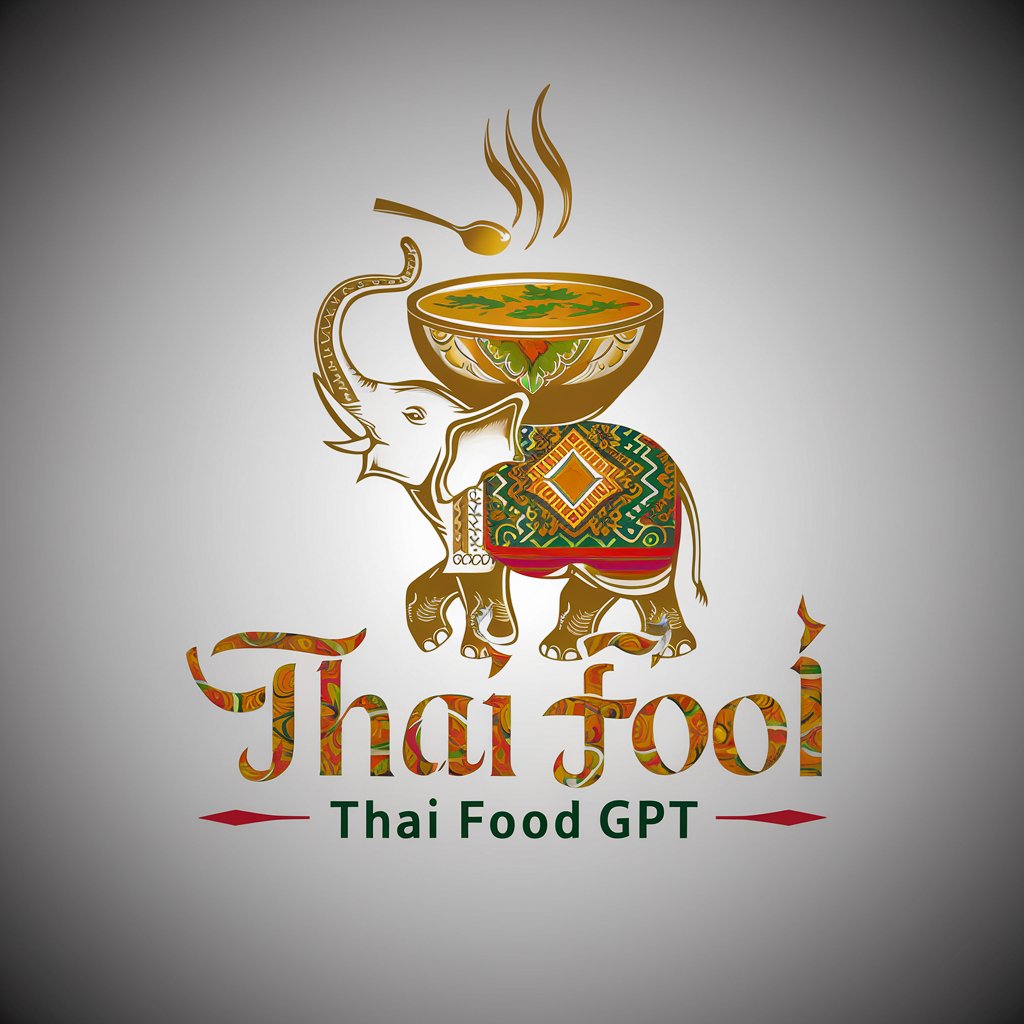Thai Food - Thai Cuisine Expert

Welcome! Let's explore the vibrant world of Thai cuisine together.
Explore Thai cuisine with AI precision.
What are the key ingredients in making a perfect Tom Yum soup?
Can you explain the difference between Pad Thai and Pad See Ew?
What are some popular Thai street foods?
How can I make a traditional Thai Green Curry at home?
Get Embed Code
Overview of Thai Food GPT
Thai Food GPT is a specialized digital assistant designed to provide comprehensive information on Thai cuisine, including dishes, ingredients, and cooking techniques. It is built to cater to enthusiasts of Thai food, offering insights into the rich flavors, ingredients, and culinary practices that define this vibrant cuisine. The GPT offers a plethora of information ranging from detailed recipes, the cultural significance of certain dishes, to advice on where to find authentic Thai ingredients or dining experiences. For example, if someone is curious about the intricate balance of flavors in a Tom Yum Goong or wants to learn how to make a perfect Pad Thai, Thai Food GPT can provide step-by-step guidance, ingredient substitutions, and even history behind these dishes. Powered by ChatGPT-4o。

Core Functions of Thai Food GPT
Detailed Recipe Guidance
Example
Providing a comprehensive recipe for Massaman Curry, including a list of authentic ingredients, step-by-step cooking instructions, and tips for achieving the perfect flavor balance.
Scenario
A home cook interested in exploring Thai cuisine wants to try making Massaman Curry from scratch but is unsure about the ingredients and the cooking process.
Ingredient Insights
Example
Explaining the significance and culinary uses of Galangal, Kaffir Lime Leaves, and Lemongrass in Thai cooking, including possible substitutes if these are not readily available.
Scenario
An individual shopping for ingredients to prepare a Thai dish struggles to find Galangal and is looking for suitable substitutes without compromising the authenticity of the flavors.
Restaurant Recommendations
Example
Recommending authentic Thai restaurants in various cities, tailored to the user's preferences for regional dishes or dietary restrictions.
Scenario
A traveler visiting a new city wishes to experience authentic Thai dining and seeks recommendations for restaurants known for specific regional specialties or vegetarian options.
Target User Groups for Thai Food Services
Culinary Enthusiasts
Individuals with a passion for cooking and exploring new cuisines, especially those keen on mastering Thai dishes and understanding the culinary philosophy behind Thai food.
Travelers and Foodies
Travelers seeking to explore Thai culture through its cuisine, and foodies interested in discovering and experiencing authentic Thai dining, whether locally or abroad.
Professional Chefs and Culinary Students
Professionals looking to expand their repertoire with Thai cuisine and culinary students seeking to deepen their understanding of Thai cooking techniques and ingredients.

How to Use Thai Food
1. Start Free
Begin by visiting yeschat.ai to access a free trial of the Thai Food GPT without needing to log in or subscribe to ChatGPT Plus.
2. Explore Features
Discover the various functionalities such as detailed Thai cuisine information, restaurant recommendations, and cooking tips. No special prerequisites are needed.
3. Ask Questions
Utilize the platform to ask specific questions about Thai dishes, ingredients, and cooking techniques for personalized and informative responses.
4. Use Cases
Leverage Thai Food for various purposes including learning new recipes, understanding ingredient substitutes, or finding authentic Thai restaurants.
5. Maximize Experience
For an optimal experience, provide detailed inquiries and use the provided information to explore or cook Thai cuisine, enhancing your culinary skills.
Try other advanced and practical GPTs
Campground Finder
Discover, Plan, and Explore with AI

Fast Food
Empowering healthier fast food decisions with AI.

Prof. Nigri
Empowering Academic Excellence with AI

Healthy Food Guide - Delicious Recipes and Diets
AI-powered Healthy Eating Guide

Experto Autocad 2024
Empower your design skills with AI

blender_3d의 기하학 노드 선택 교육
Master Geometry Nodes with AI-powered training

TechTalk with Zoe
Demystifying technology with AI conversations

Dining
Empowering Culinary Discoveries with AI

Unicorn Finder
Unveil Tech Giants, Power Your Insights

Sam Good AI Agile Coach
Empowering Agile Journeys with AI

Sam, Top Executive CV advisor
Elevate Your Executive Profile with AI-Powered Insights

Sam the Supporter
Empowering support with AI insight.

Detailed Q&A About Thai Food
What are the essential ingredients in Thai cuisine?
Thai cuisine is characterized by a balance of five flavors: sweet, sour, salty, bitter, and spicy. Essential ingredients include lemongrass, galangal, kaffir lime leaves, Thai basil, fish sauce, and coconut milk, which are foundational to creating its distinctive flavors.
How can I make a vegetarian version of Pad Thai?
To make a vegetarian Pad Thai, substitute fish sauce with soy sauce or a vegan fish sauce alternative. Replace the traditional protein with tofu or a mix of vegetables like carrots, bell peppers, and bean sprouts. Use flat rice noodles, tamarind paste, and peanuts for authenticity.
What is the difference between green, red, and yellow Thai curries?
The difference lies in the color and heat level of the chilies used in the curry paste. Green curry uses fresh green chilies and is usually the hottest. Red curry is made with dried red chilies, offering a moderate heat. Yellow curry, milder and richer, is made with turmeric and sometimes curry powder, giving it its yellow hue.
Can you recommend a simple Thai dish for beginners to try at home?
Tom Yum Soup is a great starter dish. It's a flavorful broth made with shrimp, mushrooms, lemongrass, galangal, kaffir lime leaves, fish sauce, and lime juice. It balances the quintessential Thai flavors of sour, spicy, and salty, and is relatively simple to prepare.
How do I find authentic Thai restaurants in my area?
To find authentic Thai restaurants, look for places that offer regional specialties, use traditional ingredients, and have Thai chefs. Online reviews, culinary forums, and Thai community recommendations are valuable resources. Additionally, exploring areas with a significant Thai population can lead to authentic finds.
